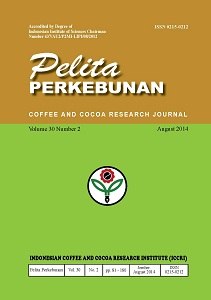Use of Trapping for Controlling of Coffee Berry Borer (Hypothenemus hampei)

Main Article Content
Abstract
Studies on the field trapping of coffee berry borer (CBB, Hypothenemus hampei) have been conducted to evaluate trap color, trap design and lures (attractant substances). The trials were conducted in a Robusta coffee plantation in East Java during August to December 2004. The trap color evaluated were red, orange, yellow, green and blue, set up in the coffee plantation using a four funnels trap. The traps installed on wood poles at a height of 175 cm above ground and placed among coffee trees. Observations were conducted every day for a week. Result of the study showed that the red and blue color traps captured CBB significantly higher than the others. During a week, the red color captured 1694 CBB adults while the blue one captured 1619 CBB adults. Peak number of captured CBB of the red and blue trapping occurred on the third day with the number of CBB of 416 and 395, respectively. In the evaluation of trapping design, four types of trapping were tried at the same location. The types of trapping were single funnel red trapping, four funnel red trapping, bottle trap with two straight opposite holes, and bottle trapping with two-zigzag holes. Bottle trapping was made of plastic bottle of 1.5-litre capacity, provided with two holes at its opposite wall. Setting up of the trapping in the field and the observation time were in the same way with the trial in trapping color evaluation. Results obtained indicated that the bottle trapping with two straight opposite holes captured the highest number of CBB followed by four funnel red trapping i.e. 547 and 69 per week, respectively. The peak number of trapped CBB occurred at the third day, as at the color trials. Furthermore, four lures have been evaluated int order to obtain the most effective substances for CBB trapping. Substances of A, B, C and D were set up in a coffee plantation using two types of trapping, four funnel red trapping and bottle trapping with two straight opposite holes. The results showed that the substances of B, C and D captured higher CBB adult than A. Nevertheless, this results was not fully convincing since the number of CBB trapped was low, which was due to low population of the CBB during the last trial. Key words: Coffee, trapping, coffee berry borer (CBB), Hypothenemus hampei, trap color, trap desain, lure
Article Details
How to Cite
Wiryadiputra, S. (2006). Use of Trapping for Controlling of Coffee Berry Borer (Hypothenemus hampei). Pelita Perkebunan (a Coffee and Cocoa Research Journal), 22(2). https://doi.org/10.22302/iccri.jur.pelitaperkebunan.v22i2.37
Issue
Section
Articles

This work is licensed under a Creative Commons Attribution-NonCommercial 4.0 International License.
Authors who publish with this journal agree to the following terms:
- Authors retain copyright and grant the journal right of first publication with the work simultaneously licensed under a Creative Commons Attribution License that allows others to share the work with an acknowledgement of the work's authorship and initial publication in this journal.
- Authors are able to enter into separate, additional contractual arrangements for the non-exclusive distribution of the journal's published version of the work (e.g., post it to an institutional repository or publish it in a book), with an acknowledgement of its initial publication in this journal.
- Authors are permitted and encouraged to post their work online (e.g., in institutional repositories or on their website) prior to and during the submission process, as it can lead to productive exchanges, as well as earlier and greater citation of published work (See The Effect of Open Access).

